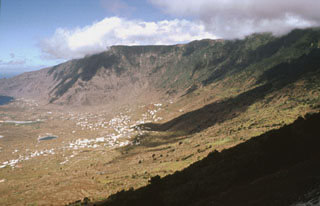Report on Hierro (Spain) — 27 June-3 July 2012
Smithsonian Institution / US Geological Survey
Weekly Volcanic Activity Report, 27 June-3 July 2012
Managing Editor: Sally Sennert.
Please cite this report as:
Global Volcanism Program, 2012. Report on Hierro (Spain) (Sennert, S, ed.). Weekly Volcanic Activity Report, 27 June-3 July 2012. Smithsonian Institution and US Geological Survey.
Hierro
Spain
27.73°N, 18.03°W; summit elev. 1500 m
All times are local (unless otherwise noted)
On the night of 24 June, a M 3.1 earthquake occurred offshore N of El Hierro island at a depth of 20 km. After that event, both the seismic activity and the deformation greatly increased. The seismicity, initially located N of the island in the El Golfo area, migrated S, then later to the W, along the E-W rift zone. On 27 June, the Plan de Protección Civil por Riesgo Volcánico (PEVOLCA) raised the Alert Level to Yellow (on a three-color, traffic-light scale) for areas near El Julan (along the SW coast) and La Dehesa; The Alert Level remained at Green for the rest of the island.
On 28 June, seismicity migrated to the SW in Las Calmas Sea and remained SW of the island, mainly offshore, until 3 July. The depth of the events was concentrated around 20 km. Since 24 June, more than 1,500 events have been located, and more than 250 of those events were M 2.7 and higher and often felt by residents. The biggest event was a M 4.4 that occurred on 2 July at 2242, located offshore SW the island, at 19 km depth. High deformation rates were measured by every GPS station on the island, reaching 8 cm in the horizontal component and about 10 cm of vertical displacement.
Geological Summary. The triangular island of Hierro is the SW-most and least studied of the Canary Islands. The massive shield volcano is truncated by a large NW-facing escarpment formed as a result of gravitational collapse of El Golfo volcano about 130,000 years ago. The steep-sided scarp towers above a low lava platform bordering 12-km-wide El Golfo Bay, and three other large submarine landslide deposits occur to the SW and SE. Three prominent rifts oriented NW, NE, and S form prominent topographic ridges. The subaerial portion of the volcano consists of flat-lying Quaternary basaltic and trachybasaltic lava flows and tuffs capped by numerous young cinder cones and lava flows. Holocene cones and flows are found both on the outer flanks and in the El Golfo depression. Hierro contains the greatest concentration of young vents in the Canary Islands. Uncertainty surrounds the report of an eruption in 1793. A submarine eruption took place about 2 km SSW off the southern point of the island during 2011-12.

